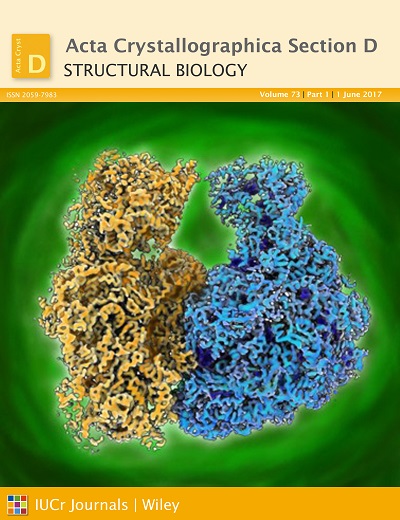Introducing the Proceedings of the CCP-EM Spring Symposium
 The Proceedings of the CCP-EM Spring Symposium have been
published in Acta Crystallographica Section D: Structural Biology http://journals.iucr.org/d/issues/2017/06/00/index.html.
The symposium is an annual conference which aims to review and highlight
state-of-the-art developments in macromolecular cyro-electron microscopy in an
accessible and convivial manner.
The Proceedings of the CCP-EM Spring Symposium have been
published in Acta Crystallographica Section D: Structural Biology http://journals.iucr.org/d/issues/2017/06/00/index.html.
The symposium is an annual conference which aims to review and highlight
state-of-the-art developments in macromolecular cyro-electron microscopy in an
accessible and convivial manner.
Cryo-EM is currently in a golden age: multiple, symbiotic improvements in instrumentation technology have resulted in vastly improved signal-to-noise allowing a step-change in resolution and scale. Indeed such is the pace of development that the term “resolution revolution”, first coined in 2014, is fast becoming a cliché. This has propelled cyro-EM into the mainstream, evidenced by the exponential rise in the number of EM-derived structures deposited in the PDB and attracting high numbers of new researchers into the field. These new methods have opened a rich tranche of new biological systems to explore, including those that were well hidden from the bright light of other structural biology disciplines. As such, in this symposium the organisers focused on emerging methods – the how, and highlight applications – the why.
The sharp increase in PDB models and experimental map depositions in the EMDB is quantified in the article from Ardan Patwardhan [(2017). Acta Cryst. D73, 503-508]. Arising from that is the popularity of the RELION software package for single particle reconstruction (SPR), described by authors Schores Scheres and Rafael Fernanadez-Leiro [(2017). Acta Cryst. D73, 496-502].
An article by Tom Burnley et al. [(2017). Acta Cryst. D73, 469-477] introduces the CCP-EM software suite, connecting multiple tools for the docking, refinement and validation of such structures. It should be noted that the “revolution” is by no means limited to SPR only. The same hardware improvements produce evermore detailed tomograms and Daniel Castano-Diez [(2017). Acta Cryst. D73, 478-487] describes the use of the Dynamo software package for subtomogram averaging. Of course these works hinge on the availability of experimental data and this, in turn, relies on the accessibility of high-end instrumentation. Daniel Clare et al. [(2017). Acta Cryst. D73, 488-495] describe the first year of operation at the Electron Bio-Imaging Centre, the national UK facility.
The availability of high–resolution maps has shown the potential of using SPR as a tool for structure-based inhibitor design and sparked industrial interest in the technique, and its application is expected to be important in the coming years. Articles from Shawn Rawson et al. [(2017). Acta Cryst. D73, 534-540] and Edward Morris and Paula da Fonseca [(2017). Acta Cryst. D73, 522-533] both provide reviews on this subject. Allesandro Costa and Marcus Wilson [(2017). Acta Cryst. D73, 541-548] review the application of cryo-EM to chromatin, highlighting where new techniques can provide more detail on important biological systems. The work on ribosome machinery presented by Abid Javed et al. [(2017). Acta Cryst. D73, 509-521] highlights the complementary techniques available to researchers.
CCP-EM would like to thank MRC for their funding and support. CCP-EM would also like to thank the authors for their contributions to this first edition along with thanking the editors of this issue Tom Burnley, Paula da Fonseca and Randy Read. The methods and applications presented are a glimpse of what can be expected in the coming years for cryo-EM. We hope to be able to present and document these exciting developments for many more years with the Acta Crystallographica Section D Proceedings of the CCP-EM Spring Symposium.

